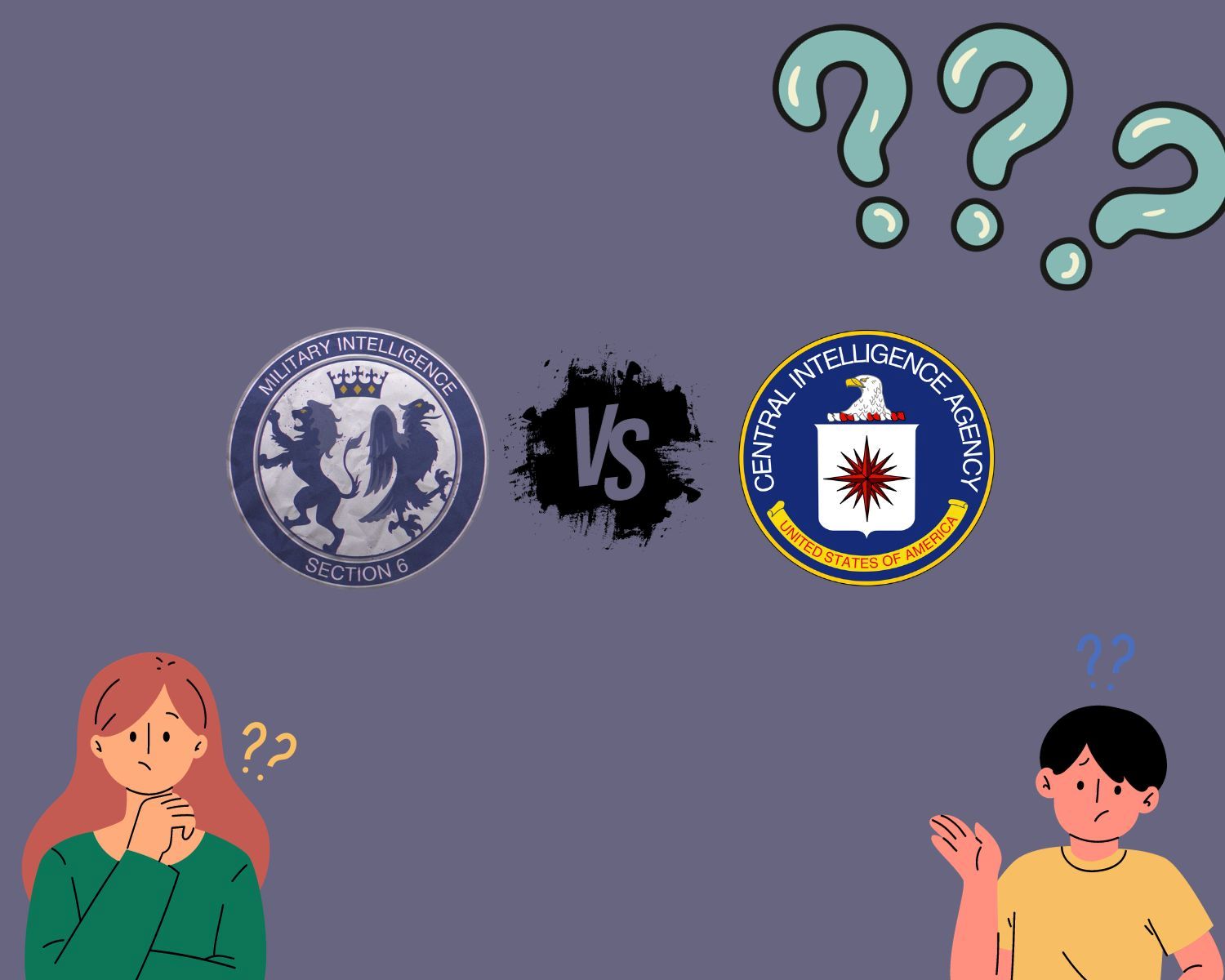Home>World News>MI6 Vs CIA: Which Secret Intelligence Agency Reigns Supreme?


World News
MI6 Vs CIA: Which Secret Intelligence Agency Reigns Supreme?
Published: January 19, 2024
Discover the latest world news on the MI6 and CIA, and find out which secret intelligence agency holds the upper hand in global affairs. Stay informed with our in-depth analysis and comparisons.
(Many of the links in this article redirect to a specific reviewed product. Your purchase of these products through affiliate links helps to generate commission for Regretless.com, at no extra cost. Learn more)
Table of Contents
- Introduction
- History of MI6
- History of CIA
- Organizational Structure of MI6
- Organizational Structure of CIA
- Mission and Objectives of MI6
- Mission and Objectives of CIA
- Intelligence Operations of MI6
- Intelligence Operations of CIA
- Technological Capabilities of MI6
- Technological Capabilities of CIA
- Collaboration and Alliances
- Controversies and Criticisms
- Conclusion
Introduction
The world of international espionage and covert operations has long been a subject of fascination, intrigue, and speculation. At the heart of this clandestine realm are the secret intelligence agencies that operate behind the scenes, gathering intelligence, carrying out covert missions, and shaping the course of global events. Among these agencies, two stand out as titans in the world of espionage: MI6 and the CIA.
MI6, formally known as the Secret Intelligence Service, is the British foreign intelligence service, renowned for its storied history and legendary exploits. On the other side of the Atlantic, the Central Intelligence Agency, or CIA, represents the United States' premier intelligence agency, with a reputation for its far-reaching influence and formidable capabilities.
As the world evolves and geopolitical dynamics shift, the roles of MI6 and the CIA continue to be pivotal in shaping global affairs. Their covert activities, technological prowess, and strategic alliances have a profound impact on international relations, security, and diplomacy. Understanding the inner workings, missions, and controversies surrounding these intelligence agencies is crucial for comprehending the intricate web of global espionage and its implications for the world at large.
In this comprehensive exploration, we delve into the rich histories, organizational structures, missions, intelligence operations, technological capabilities, collaborations, and controversies that define MI6 and the CIA. By shedding light on these secretive entities, we aim to unravel the enigma surrounding these intelligence giants and gain insight into the complex world of international espionage.
Read more: US Vs UK Shameless: Which Reigns Supreme?
History of MI6
The history of MI6, officially known as the Secret Intelligence Service (SIS), is steeped in intrigue, espionage, and pivotal moments that have shaped the course of global history. Established in 1909, MI6 was born out of the need for a dedicated foreign intelligence service to gather crucial information and conduct covert operations to safeguard British interests abroad. Its origins can be traced back to the early 20th century, a time of geopolitical turbulence and shifting power dynamics across the globe.
MI6's formative years were marked by the clandestine maneuverings of its operatives in various international theaters, from Europe to the Middle East and beyond. During World War I, MI6 played a pivotal role in intelligence gathering and covert operations, contributing significantly to the Allied war effort. The agency's exploits during this tumultuous period solidified its reputation as a formidable force in the world of espionage.
In the interwar years, MI6 continued to expand its reach and capabilities, adapting to the evolving geopolitical landscape and the emergence of new threats. The onset of World War II thrust MI6 into the forefront of covert operations, with its operatives undertaking daring missions behind enemy lines and gathering crucial intelligence to support the war effort. The agency's pivotal role in strategic intelligence gathering and covert actions during this global conflict further cemented its status as a preeminent intelligence agency.
The post-war era witnessed MI6 navigating the complexities of the Cold War, where the agency became deeply entrenched in the shadowy world of espionage and counterintelligence. The agency's activities during this period, often shrouded in secrecy, encompassed a wide array of clandestine operations, intelligence gathering, and strategic alliances aimed at countering the influence of rival powers.
As the 21st century unfolded, MI6 continued to adapt to the evolving landscape of global security threats, terrorism, and cyber warfare. The agency's role in combating modern-day challenges while upholding its traditional espionage capabilities underscores its enduring significance in the realm of international intelligence.
Throughout its history, MI6 has remained at the forefront of global intelligence, navigating the complexities of international relations, geopolitical upheavals, and emerging security threats. Its legacy is intertwined with a tapestry of clandestine operations, strategic alliances, and pivotal moments that have left an indelible mark on the annals of global espionage.
History of CIA
The history of the Central Intelligence Agency (CIA) is a captivating saga of clandestine operations, intelligence gathering, and global influence. Established in 1947 through the National Security Act, the CIA emerged as the United States' premier intelligence agency, tasked with the critical mission of gathering foreign intelligence and conducting covert operations to safeguard national security interests.
The early years of the CIA were marked by the onset of the Cold War, a period characterized by intense geopolitical rivalries, ideological conflicts, and the looming specter of nuclear confrontation. During this era, the CIA played a pivotal role in shaping the course of global events, conducting covert operations, and gathering intelligence to counter the expansion of Soviet influence and communist ideologies.
One of the most iconic chapters in the CIA's history unfolded during the Cuban Missile Crisis in 1962, a harrowing standoff between the United States and the Soviet Union that brought the world to the brink of nuclear war. The CIA's intelligence-gathering capabilities and strategic analysis played a crucial role in uncovering the presence of Soviet missiles in Cuba, providing vital information that influenced the course of the crisis and averted a catastrophic conflict.
The agency's involvement in covert operations during the Cold War extended beyond the Western Hemisphere, with operations in Asia, Africa, and the Middle East. These clandestine activities aimed to influence political outcomes, gather intelligence, and counter the spread of communism, shaping the geopolitical landscape of the era.
In the aftermath of the Cold War, the CIA adapted to the evolving global security landscape, confronting new challenges such as terrorism, proliferation of weapons of mass destruction, and cyber threats. The agency's role in combating these modern-day challenges, often operating in the shadows, underscored its enduring significance in international intelligence and security.
The CIA's history is replete with a tapestry of covert operations, intelligence successes, and controversies that have left an indelible mark on the annals of global espionage. Its legacy continues to shape the world of intelligence and national security, reflecting a history intertwined with pivotal moments that have influenced the course of global affairs.
Organizational Structure of MI6
The organizational structure of MI6, also known as the Secret Intelligence Service (SIS), is intricately designed to facilitate its core missions of gathering foreign intelligence, conducting covert operations, and safeguarding British national security interests. At the helm of MI6 is the Chief of the Secret Intelligence Service, who oversees the agency's strategic direction and operational activities. Beneath this leadership, MI6's organizational framework comprises specialized divisions and departments, each playing a distinct role in fulfilling the agency's objectives.
Chief of the Secret Intelligence Service
At the apex of MI6's organizational hierarchy is the Chief of the Secret Intelligence Service, a pivotal figure responsible for setting the agency's strategic priorities, overseeing intelligence operations, and liaising with key government officials. The Chief plays a central role in shaping MI6's engagement with foreign intelligence partners and coordinating the agency's activities on the global stage.
Operations and Intelligence Divisions
MI6's operational and intelligence divisions form the backbone of the agency's clandestine activities. These divisions are responsible for gathering actionable intelligence, conducting covert missions, and analyzing information vital to national security. Operatives within these divisions are deployed worldwide, leveraging their expertise to gather critical intelligence and execute sensitive operations in alignment with MI6's strategic objectives.
Technical Support and Cyber Capabilities
In an era dominated by technological advancements, MI6 has bolstered its organizational structure to incorporate specialized units focused on technical support and cyber capabilities. These units are dedicated to harnessing cutting-edge technologies, conducting cyber operations, and countering digital threats that pose risks to national security. MI6's technological prowess is integral to its intelligence-gathering efforts and its ability to navigate the complexities of modern espionage.
Liaison and Collaboration Units
MI6's organizational structure includes dedicated units tasked with fostering collaboration and partnerships with foreign intelligence services and international allies. These units play a crucial role in facilitating information sharing, joint operations, and strategic alliances, enhancing MI6's global reach and operational effectiveness. The agency's collaborative endeavors are instrumental in addressing transnational threats and advancing shared security objectives.
Support Services and Administration
Support services and administrative functions form an essential component of MI6's organizational structure, providing logistical, financial, and administrative support to the agency's operational activities. These units ensure the seamless functioning of MI6's operations, enabling operatives to focus on their intelligence-gathering and covert missions with the necessary infrastructure and resources at their disposal.
MI6's organizational structure embodies a multifaceted and agile framework designed to navigate the complexities of global espionage, counter emerging security threats, and uphold the agency's legacy as a premier intelligence service. The seamless integration of specialized divisions, strategic leadership, and collaborative partnerships underscores MI6's enduring commitment to safeguarding national security interests and shaping the course of international affairs.
Organizational Structure of CIA
The organizational structure of the Central Intelligence Agency (CIA) is a sophisticated framework meticulously designed to fulfill its critical mission of gathering foreign intelligence, conducting covert operations, and safeguarding the national security interests of the United States. At the helm of the CIA is the Director of the Central Intelligence Agency, a pivotal figure responsible for shaping the agency's strategic direction, coordinating intelligence activities, and liaising with key government officials and international partners. The director plays a central role in guiding the CIA's engagement on the global stage and overseeing its multifaceted operations.
Directorate of Operations
One of the core components of the CIA's organizational structure is the Directorate of Operations, often referred to as the clandestine service. This division is responsible for carrying out covert operations, gathering actionable intelligence through human intelligence sources, and conducting sensitive missions in alignment with the agency's strategic objectives. Operatives within the Directorate of Operations are deployed worldwide, leveraging their expertise to gather critical intelligence and execute clandestine activities aimed at advancing national security interests.
Directorate of Analysis
The Directorate of Analysis forms another integral pillar of the CIA's organizational framework. This division is dedicated to the comprehensive analysis of intelligence gathered from various sources, providing strategic assessments, forecasts, and in-depth insights to policymakers and government officials. Analysts within this directorate play a crucial role in distilling complex information into actionable intelligence, contributing to the formulation of informed policies and strategic decisions.
Directorate of Science and Technology
In an era dominated by technological advancements, the CIA has established the Directorate of Science and Technology, focusing on harnessing cutting-edge technologies, conducting research and development, and countering emerging threats in the digital domain. This division's expertise in technical innovation and cyber capabilities is pivotal to the CIA's intelligence-gathering efforts and its ability to navigate the complexities of modern espionage in the digital age.
Directorate of Support
The Directorate of Support plays a vital role in providing logistical, financial, and administrative support to the CIA's operational activities. This division ensures the seamless functioning of the agency's operations, offering essential services such as procurement, finance, security, and infrastructure support. Its contributions enable operatives to focus on their intelligence-gathering and covert missions with the necessary resources and infrastructure at their disposal.
Collaboration and Alliances
The CIA's organizational structure also encompasses units dedicated to fostering collaboration and partnerships with foreign intelligence services and international allies. These units play a crucial role in facilitating information sharing, joint operations, and strategic alliances, enhancing the CIA's global reach and operational effectiveness. The agency's collaborative endeavors are instrumental in addressing transnational threats and advancing shared security objectives on the global stage.
The seamless integration of specialized divisions, strategic leadership, and collaborative partnerships underscores the CIA's enduring commitment to safeguarding national security interests, influencing global affairs, and navigating the complex web of international espionage.
This detailed organizational structure empowers the CIA to effectively carry out its multifaceted missions, adapt to evolving security challenges, and maintain its position as a preeminent intelligence agency on the world stage.
Mission and Objectives of MI6
MI6, the Secret Intelligence Service, operates with a mission deeply rooted in safeguarding the national security interests of the United Kingdom. At its core, MI6 is tasked with gathering foreign intelligence, conducting covert operations, and countering threats that pose risks to the country's security and well-being. The agency's overarching mission encompasses a multifaceted set of objectives aimed at advancing its strategic imperatives and upholding the nation's safety in an ever-evolving global landscape.
Strategic Intelligence Gathering
One of MI6's primary objectives is to gather strategic intelligence from foreign sources, providing critical insights into geopolitical developments, emerging security threats, and the activities of adversarial entities. By leveraging a global network of operatives and liaising with international partners, MI6 seeks to acquire actionable intelligence that informs the decision-making processes of the British government, enabling informed policies and proactive measures to safeguard national interests.
Covert Operations and Counterintelligence
MI6 is entrusted with the task of conducting covert operations designed to advance the United Kingdom's security objectives, often operating in clandestine environments to mitigate threats and disrupt hostile activities. These covert operations encompass a spectrum of activities, including espionage, sabotage, and counterterrorism efforts aimed at neutralizing threats to national security. Additionally, MI6 is dedicated to countering the activities of hostile intelligence services, protecting sensitive information, and safeguarding the integrity of the nation's defenses.
Cyber and Technological Capabilities
In an era defined by technological advancements and digital threats, MI6 has embraced the mission of harnessing cutting-edge technologies to bolster its intelligence-gathering capabilities and counter emerging cyber threats. The agency's objectives include developing sophisticated cyber capabilities, conducting digital espionage, and safeguarding the United Kingdom's critical infrastructure from cyber intrusions. MI6's commitment to technological innovation is integral to its mission of staying ahead of evolving security challenges in the digital domain.
Diplomatic Engagement and Alliances
MI6 actively engages in diplomatic initiatives and forges strategic alliances with foreign intelligence services to foster collaborative efforts in addressing transnational security threats. By nurturing partnerships with international allies, the agency aims to enhance information sharing, joint operations, and intelligence cooperation, contributing to a collective approach in safeguarding global stability and countering common adversaries.
Upholding National Security Imperatives
Ultimately, MI6's mission and objectives converge on the overarching goal of upholding the national security imperatives of the United Kingdom. Through its intelligence-gathering endeavors, covert operations, technological capabilities, and collaborative engagements, the agency remains steadfast in its commitment to safeguarding the nation from external threats, preserving its sovereignty, and shaping the course of international affairs in alignment with the country's strategic interests.
MI6's mission and objectives reflect a resolute dedication to advancing the national security interests of the United Kingdom, navigating the complexities of global security challenges, and upholding its legacy as a premier intelligence service on the world stage.
Mission and Objectives of CIA
The Central Intelligence Agency (CIA) operates with a mission deeply rooted in safeguarding the national security interests of the United States. At its core, the CIA is tasked with gathering foreign intelligence, conducting covert operations, and countering threats that pose risks to the country's security and well-being. The agency's overarching mission encompasses a multifaceted set of objectives aimed at advancing its strategic imperatives and upholding the nation's safety in an ever-evolving global landscape.
Strategic Intelligence Gathering
One of the CIA's primary objectives is to gather strategic intelligence from foreign sources, providing critical insights into geopolitical developments, emerging security threats, and the activities of adversarial entities. By leveraging a global network of operatives and liaising with international partners, the CIA seeks to acquire actionable intelligence that informs the decision-making processes of the U.S. government, enabling informed policies and proactive measures to safeguard national interests.
Covert Operations and Counterintelligence
The CIA is entrusted with the task of conducting covert operations designed to advance the United States' security objectives, often operating in clandestine environments to mitigate threats and disrupt hostile activities. These covert operations encompass a spectrum of activities, including espionage, sabotage, and counterterrorism efforts aimed at neutralizing threats to national security. Additionally, the CIA is dedicated to countering the activities of hostile intelligence services, protecting sensitive information, and safeguarding the integrity of the nation's defenses.
Cyber and Technological Capabilities
In an era defined by technological advancements and digital threats, the CIA has embraced the mission of harnessing cutting-edge technologies to bolster its intelligence-gathering capabilities and counter emerging cyber threats. The agency's objectives include developing sophisticated cyber capabilities, conducting digital espionage, and safeguarding the United States' critical infrastructure from cyber intrusions. The CIA's commitment to technological innovation is integral to its mission of staying ahead of evolving security challenges in the digital domain.
Diplomatic Engagement and Alliances
The CIA actively engages in diplomatic initiatives and forges strategic alliances with foreign intelligence services to foster collaborative efforts in addressing transnational security threats. By nurturing partnerships with international allies, the agency aims to enhance information sharing, joint operations, and intelligence cooperation, contributing to a collective approach in safeguarding global stability and countering common adversaries.
Upholding National Security Imperatives
Ultimately, the CIA's mission and objectives converge on the overarching goal of upholding the national security imperatives of the United States. Through its intelligence-gathering endeavors, covert operations, technological capabilities, and collaborative engagements, the agency remains steadfast in its commitment to safeguarding the nation from external threats, preserving its sovereignty, and shaping the course of international affairs in alignment with the country's strategic interests.
The CIA's mission and objectives reflect a resolute dedication to advancing the national security interests of the United States, navigating the complexities of global security challenges, and upholding its legacy as a premier intelligence agency on the world stage.
Intelligence Operations of MI6
The intelligence operations of MI6, the Secret Intelligence Service, are characterized by a diverse array of clandestine activities and strategic initiatives aimed at gathering foreign intelligence, countering threats, and advancing the national security interests of the United Kingdom. Operating on a global scale, MI6's intelligence operations encompass a spectrum of covert missions, espionage endeavors, and strategic engagements designed to navigate the complexities of international espionage.
At the heart of MI6's intelligence operations is the deployment of operatives in various international theaters to gather actionable intelligence, conduct surveillance, and infiltrate high-value targets. These clandestine activities are meticulously planned and executed to acquire critical insights into geopolitical developments, emerging security threats, and the activities of adversarial entities. MI6's operatives, often operating under deep cover, leverage their expertise and strategic acumen to navigate complex environments and gather intelligence vital to national security interests.
Moreover, MI6's intelligence operations extend beyond traditional espionage, encompassing cyber operations, technical intelligence gathering, and signals intelligence. The agency harnesses cutting-edge technologies to conduct digital espionage, counter cyber threats, and safeguard the United Kingdom's critical infrastructure from potential intrusions. MI6's technological capabilities play a pivotal role in navigating the complexities of modern espionage in the digital age, enabling the agency to stay ahead of evolving security challenges and emerging threats in the cyber domain.
Collaboration and information sharing are also fundamental aspects of MI6's intelligence operations. The agency actively engages with foreign intelligence services and international allies to foster cooperative efforts in addressing transnational security threats. By nurturing strategic partnerships, MI6 enhances its global reach, leverages shared intelligence resources, and contributes to collective endeavors aimed at countering common adversaries and safeguarding global stability.
In essence, MI6's intelligence operations epitomize a multifaceted and agile approach to gathering foreign intelligence, conducting covert missions, and countering emerging security threats. The agency's enduring commitment to advancing the national security imperatives of the United Kingdom underscores its pivotal role in shaping the course of international affairs and navigating the intricate web of global espionage.
Intelligence Operations of CIA
The intelligence operations of the Central Intelligence Agency (CIA) are a multifaceted and dynamic endeavor, encompassing a wide spectrum of clandestine activities, strategic initiatives, and cutting-edge intelligence-gathering capabilities. Operating on a global scale, the CIA's intelligence operations are designed to gather foreign intelligence, conduct covert missions, and counter emerging security threats in alignment with the national security interests of the United States.
At the core of the CIA's intelligence operations lies the Directorate of Operations, often referred to as the clandestine service. This division is tasked with deploying operatives worldwide to gather actionable intelligence, conduct surveillance, and infiltrate high-priority targets. These covert activities, meticulously planned and executed, provide critical insights into geopolitical developments, emerging security threats, and the activities of adversarial entities. The CIA's operatives, operating under deep cover, leverage their expertise and strategic acumen to navigate complex environments and gather intelligence vital to national security interests.
In addition to traditional espionage, the CIA's intelligence operations encompass advanced technological capabilities, including cyber operations, technical intelligence gathering, and signals intelligence. The agency harnesses cutting-edge technologies to conduct digital espionage, counter cyber threats, and safeguard the United States' critical infrastructure from potential intrusions. The CIA's technological prowess and expertise in the digital domain enable the agency to stay ahead of evolving security challenges, providing a strategic advantage in navigating the complexities of modern espionage.
Collaboration and information sharing are integral components of the CIA's intelligence operations. The agency actively engages in diplomatic initiatives and forges strategic alliances with foreign intelligence services to foster cooperative efforts in addressing transnational security threats. By nurturing partnerships with international allies, the CIA enhances its global reach, leverages shared intelligence resources, and contributes to collective endeavors aimed at countering common adversaries and safeguarding global stability.
In essence, the CIA's intelligence operations epitomize a comprehensive and agile approach to gathering foreign intelligence, conducting covert missions, and countering emerging security threats. The agency's enduring commitment to advancing the national security imperatives of the United States underscores its pivotal role in shaping the course of international affairs and navigating the intricate web of global espionage.
Technological Capabilities of MI6
The technological capabilities of MI6, the Secret Intelligence Service, represent a sophisticated and cutting-edge arsenal that empowers the agency to navigate the complexities of modern espionage and counter emerging digital threats. In an era defined by rapid technological advancements and the pervasive influence of cyberspace, MI6 has strategically invested in state-of-the-art technologies and cyber capabilities to bolster its intelligence-gathering endeavors and safeguard the national security interests of the United Kingdom.
At the forefront of MI6's technological prowess is its proficiency in cyber operations and digital espionage. The agency has cultivated a cadre of cyber experts adept at navigating the digital domain, conducting covert cyber operations, and countering cyber threats that pose risks to the nation's critical infrastructure. MI6's cyber capabilities encompass a wide spectrum of activities, including digital reconnaissance, cyber counterintelligence, and the development of advanced tools to penetrate and gather intelligence from secure digital networks.
Moreover, MI6 has harnessed the power of advanced surveillance technologies to enhance its intelligence-gathering capabilities. The agency leverages cutting-edge surveillance equipment, unmanned aerial vehicles, and sophisticated monitoring systems to conduct covert surveillance operations, gather real-time intelligence, and monitor high-value targets. This technological acumen enables MI6 to collect critical insights and actionable intelligence vital to national security interests.
In the realm of signals intelligence (SIGINT), MI6 has established a formidable technological infrastructure dedicated to intercepting and analyzing electronic communications. The agency's SIGINT capabilities encompass advanced monitoring systems, decryption technologies, and signal interception platforms designed to intercept, decipher, and analyze electronic communications from foreign adversaries. This SIGINT prowess provides MI6 with a strategic advantage in gathering intelligence from global communication networks and deciphering encrypted transmissions.
Furthermore, MI6 has embraced the frontier of artificial intelligence (AI) and machine learning to augment its analytical capabilities and process vast volumes of data. By harnessing AI-driven algorithms and predictive analytics, the agency can distill complex datasets, identify patterns, and extract actionable intelligence, enhancing its capacity to anticipate emerging security threats and inform strategic decision-making.
In essence, MI6's technological capabilities epitomize a forward-thinking approach to intelligence gathering, cyber operations, and technological innovation. The agency's adeptness in leveraging cutting-edge technologies underscores its commitment to staying ahead of evolving security challenges and shaping the course of international affairs in the digital age.
Read more: The Ultimate Steakhouse Showdown: Ruth’s Chris Vs. Longhorn Vs. Outback – Which Reigns Supreme?
Technological Capabilities of CIA
The Central Intelligence Agency (CIA) is at the forefront of technological innovation, leveraging cutting-edge capabilities to navigate the complexities of modern espionage and counter emerging digital threats. In an era defined by rapid technological advancements and the pervasive influence of cyberspace, the CIA has strategically invested in state-of-the-art technologies and cyber capabilities to bolster its intelligence-gathering endeavors and safeguard the national security interests of the United States.
One of the CIA's key technological strengths lies in its proficiency in cyber operations and digital espionage. The agency has cultivated a cadre of cyber experts adept at navigating the digital domain, conducting covert cyber operations, and countering cyber threats that pose risks to the nation's critical infrastructure. The CIA's cyber capabilities encompass a wide spectrum of activities, including digital reconnaissance, cyber counterintelligence, and the development of advanced tools to penetrate and gather intelligence from secure digital networks.
In addition to cyber operations, the CIA has harnessed the power of advanced surveillance technologies to enhance its intelligence-gathering capabilities. The agency leverages cutting-edge surveillance equipment, unmanned aerial vehicles, and sophisticated monitoring systems to conduct covert surveillance operations, gather real-time intelligence, and monitor high-value targets. This technological acumen enables the CIA to collect critical insights and actionable intelligence vital to national security interests.
Furthermore, the CIA has established a formidable technological infrastructure dedicated to signals intelligence (SIGINT), encompassing advanced monitoring systems, decryption technologies, and signal interception platforms designed to intercept, decipher, and analyze electronic communications from foreign adversaries. This SIGINT prowess provides the CIA with a strategic advantage in gathering intelligence from global communication networks and deciphering encrypted transmissions.
Moreover, the CIA has embraced the frontier of artificial intelligence (AI) and machine learning to augment its analytical capabilities and process vast volumes of data. By harnessing AI-driven algorithms and predictive analytics, the agency can distill complex datasets, identify patterns, and extract actionable intelligence, enhancing its capacity to anticipate emerging security threats and inform strategic decision-making.
In essence, the CIA's technological capabilities epitomize a forward-thinking approach to intelligence gathering, cyber operations, and technological innovation. The agency's adeptness in leveraging cutting-edge technologies underscores its commitment to staying ahead of evolving security challenges and shaping the course of international affairs in the digital age.
Collaboration and Alliances
Collaboration and alliances form the cornerstone of MI6's operational effectiveness and global reach. The agency actively engages in diplomatic initiatives and forges strategic partnerships with foreign intelligence services and international allies, fostering cooperative efforts in addressing transnational security threats and advancing shared security objectives. By nurturing these alliances, MI6 enhances its capacity to gather intelligence, conduct joint operations, and leverage collective resources to counter common adversaries.
MI6's collaborative endeavors are characterized by a commitment to information sharing and intelligence cooperation, facilitating a seamless exchange of vital insights and strategic assessments with partner agencies across the globe. This collaborative approach enables MI6 to harness a wealth of diverse perspectives, expertise, and intelligence resources, enhancing its capacity to address complex security challenges and anticipate emerging threats on the global stage.
Furthermore, MI6's strategic alliances with foreign intelligence services play a pivotal role in shaping the agency's operational effectiveness and intelligence-gathering capabilities. These partnerships enable MI6 to access unique insights, operational support, and specialized expertise, augmenting its ability to navigate complex geopolitical environments and conduct sensitive missions in alignment with shared security imperatives.
The agency's collaborative engagements extend beyond traditional bilateral partnerships, encompassing multilateral initiatives and intelligence-sharing arrangements that foster a collective approach to safeguarding global stability. By participating in multinational intelligence forums and collaborative frameworks, MI6 contributes to a unified front in countering transnational threats, promoting regional stability, and upholding shared security interests.
In essence, MI6's collaborative ethos and strategic alliances underscore the agency's commitment to advancing collective security objectives, shaping the course of international affairs, and countering evolving security challenges through a cohesive and cooperative approach. The agency's unwavering dedication to collaboration and alliances reflects its pivotal role in navigating the intricate web of global espionage and shaping a secure future for the United Kingdom and its international partners.
Controversies and Criticisms
MI6, like any intelligence agency operating in the shadows, has been embroiled in controversies and faced criticisms that have sparked public scrutiny and debate. One of the most notable controversies in MI6's history is the case of the intelligence dossier leading up to the Iraq War. The agency's role in providing intelligence that was later found to be flawed, particularly regarding the presence of weapons of mass destruction, raised serious questions about the accuracy and reliability of MI6's assessments. This controversy fueled widespread skepticism and eroded public trust in the agency's intelligence-gathering capabilities.
Additionally, MI6 has faced criticisms related to its involvement in covert operations and espionage activities that have been deemed controversial or morally ambiguous. The agency's clandestine interventions in various geopolitical hotspots, often in collaboration with foreign intelligence services, have drawn criticism for their ethical implications and the potential destabilizing effects on the regions involved. These actions have sparked debates about the ethical boundaries of espionage and the potential consequences of covert interventions on global stability.
Furthermore, MI6 has been the subject of scrutiny regarding its engagement with foreign intelligence services and alliances with international partners. The agency's collaborative efforts with foreign intelligence agencies, particularly those with differing human rights standards or controversial track records, have raised concerns about the ethical implications of such partnerships. Critics have questioned the extent to which MI6's alliances align with the United Kingdom's values and ethical standards, prompting calls for greater transparency and accountability in the agency's international engagements.
Moreover, MI6's use of surveillance technologies and cyber capabilities has sparked debates about privacy rights, civil liberties, and the potential for overreach in intelligence operations. The agency's technological prowess and digital espionage activities have faced criticism for their implications on individual privacy and the broader societal impact of mass surveillance.
In response to these controversies and criticisms, MI6 has emphasized the importance of upholding ethical standards, ensuring accountability, and maintaining transparency in its operations. The agency has acknowledged the need for continuous evaluation and refinement of its practices to address public concerns and uphold the principles of legality, proportionality, and respect for human rights in its intelligence-gathering activities.
Overall, the controversies and criticisms surrounding MI6 underscore the complex and contentious nature of intelligence operations, prompting ongoing discussions about the ethical, legal, and societal implications of espionage in the modern world.
Conclusion
In conclusion, MI6 and the CIA stand as formidable pillars in the world of international espionage, each wielding unparalleled influence, technological prowess, and strategic alliances that shape the course of global affairs. The rich histories, organizational structures, missions, intelligence operations, and technological capabilities of these intelligence agencies underscore their pivotal roles in safeguarding national security interests and navigating the complexities of modern espionage.
MI6, with its storied legacy and strategic engagements, exemplifies a commitment to gathering foreign intelligence, conducting covert operations, and countering emerging security threats while upholding the national security imperatives of the United Kingdom. The agency's collaborative ethos and strategic alliances underscore its unwavering dedication to advancing collective security objectives and shaping a secure future for the United Kingdom and its international partners.
Similarly, the CIA's multifaceted approach to intelligence gathering, cyber operations, and technological innovation reflects its resolute dedication to advancing the national security imperatives of the United States. The agency's adeptness in leveraging cutting-edge technologies underscores its commitment to staying ahead of evolving security challenges and shaping the course of international affairs in the digital age.
Both MI6 and the CIA have navigated controversies and faced criticisms, prompting ongoing discussions about the ethical, legal, and societal implications of espionage in the modern world. These debates underscore the complex and contentious nature of intelligence operations, emphasizing the importance of upholding ethical standards, ensuring accountability, and maintaining transparency in the pursuit of national security objectives.
As the world continues to evolve, the roles of MI6 and the CIA remain pivotal in addressing emerging security threats, countering adversarial activities, and fostering collaborative efforts to safeguard global stability. Their enduring legacies, technological prowess, and strategic alliances position them as indispensable entities in the intricate web of international espionage, shaping the future of global security and diplomacy.









